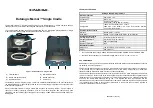
16
PURE PLUS
– Wireless weather station
• Press and hold
▲
button again for 2 sec. to activate the reception manually.
• In case the clock cannot detect the DCF-signal (for example due to disturbances, transmitting
distance, etc.), the time can be set manually.
• The clock will then work as a normal quartz clock. (see: 4.1.1 Manual setting of clock and calendar)
• The radio controlled clock receives the signals at 0:00, 3:00, 6:00 and 12.00 o'clock in the morning.
Note for radio controlled time DCF:
The time base for the radio controlled time is a Caesium Atomic Clock operated by the Physikalisch
Technische Bundesanstalt Braunschweig which has a time deviation of less than one second in one
million years. The time is coded and transmitted from Mainflingen near Frankfurt via frequency signal
DCF-77 (77.5 kHz) and has a transmitting range of approximately 1500 km. Your radio-controlled clock
receives this signal and converts it to show the precise time in summer or wintertime. The quality of
the reception depends greatly on the geographic location. In normal cases, there should be no recep-
tion problems within a 1,500 km radius around Frankfurt.
Please take note of the following:
• Recommended distance to any interfering sources like computer monitors or TV sets is a minimum
of 1.5 - 2 metres.
• Within ferro-concrete rooms (basements, superstructures), the received signal is naturally weakened.
In extreme cases, please place the unit close to a window and/or point its front or back towards the
Frankfurt transmitter.
• During night-time, the atmospheric disturbances are usually less severe and reception is possible in
most cases. A single daily reception is adequate to keep the accuracy deviation below 1 second.
4. Operation
•
Important:
Buttons will not function while scanning the outdoor transmitter signal.
• The instrument will quit the setting mode, if there is no button used within 2 minutes.
• Hold
▲
or
▼
button in setting mode, you will enter fast mode.
4.1 Time mode
• Press the
▲
or
▼
button to enter the respective display area. When changing the display area a
short beep will sound.
• TIME flashes on the display.
• You are now in the time mode
4.1.1 Manual setting of clock and calendar
• To access the setting mode, press and hold MODE button.
• The day-of-week language digit is flashing. Press
▲
or
▼
button to adjust it. Day-of-week lan-
guage: German (DE), English (En), Swedish (SW), Dutch (Du), Spanish (SP), Italian (IT) and French
(Fr).
• Press MODE button and the setting sequence is shown as follows: Year, month, date, month/day
sequence (American version) or day/month (European version), 12 (PM appears on the display after
12 h) and 24 hours system indication, hours and minutes. Press
▲
or
▼
button to make the desired
settings.
• If DCF reception is on, the manually set time will be overwritten by the DCF time when the signal is
received successfully.
4.1.2 Dual time
• Press MODE button twice in time mode.
• ZONE appears on the display.
PURE PLUS
– Radio estación meteorológica
61
4.4 Fase lunar
• La pantalla le muestra las fases actuales de la luna:
A: Luna nueva
B: Cuarto creciente
C: Media luna (primer cuarto)
D: Luna creciente
E: Luna llena
F: Luna menguante
G: Media luna (último cuarto)
H: Cuarto menguante
5. Emisor
• Después de la puesta en marcha el emisor inicia automáticamente la transmisión de los valores de
los datos exteriores al canal 1.
• Después de poner en cera correctamente el emisor exterior, cierre de nuevo con cuidado la tapa de
las pilas.
• Si el emisor no funciona correctamente realice por favor una nueva puesta en funcionamiento.
Cambie las pilas.
5.1 Emisor exterior adicional
• Si desea conectar varios emisores (Kat.No 30.3126), seleccione con el interruptor en el comparti-
mento para las pilas deslizante otro canal para cada emisor (2 o 3).
• Introduzca las pilas (2 x 1,5 V AAA) en el compartimento de las pilas. Compruebe que la polaridad
sea la correcta al introducir las pilas.
• Pulse la tecla
▼
sobre la estación base durante dos segundo y arranque la inicialización manual-
mente.
• Si ha conectado más de un emisor, con la tecla CHANNEL puede cambiar entre los canales.
• También puede ajustar un cambio de canal automático. Mantenga pulsada la tecla CHANNEL hasta
en la pantalla aparece el símbolo del círculo
para el cambio de canal automático.
• Mantenga pulsada la tecla CHANNEL para desactivar la función y el símbolo desaparece en el display.
5.2 Instalación de la estación básica y fijación del emisor
• Busque un lugar sombreado, protegido de la lluvia para el emisor. (La irradiación solar directa
falsea los valores de medición y la humedad permanente perjudica innecesariamente los compo-
nentes electrónicos).
• Coloque la estación base con los soportes plegables o con la sujeción adicional plateada en la habi-
tación. El aparato puede ser colgado en la pared mediante il dispositivo de suspensión. Evite la pro-
ximidad a otros aparatos eléctricos (Televisor, ordenador, teléfonos móviles) y objetos metálicos
macizos.
• Compruebe si se produce la transmisión de los valores de medición del emisor en el lugar de instala-
ción deseado para la estación básica (alcance en campo libre 40 metros aprox.), con paredes maci-
zas, especialmente con piezas metálicas puede reducirse considerablemente el alcance del emisor.
• Si es necesario, busque un nuevo lugar de instalación para el emisor y/o receptor.
• Si la transmisión ha sido satisfactoria, puede fijar el emisor. Monte el soporte en la pared, en el
lugar deseado. El sensor exterior simplemente se sujeta a presión en el soporte de pared. Al colocar
o retirar el sensor exterior, ambas unidades deben sujetarse con firmeza.
A
B
C
D
E
F
G
H
TFA_No. 35.1106 Anl_12_10.bel 10.12.2010 14:18 Uhr Seite 16
















































